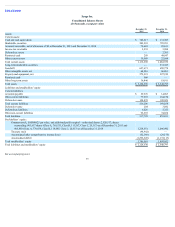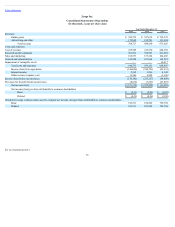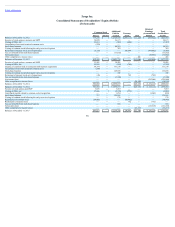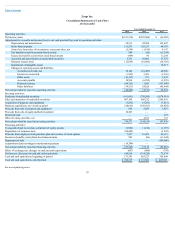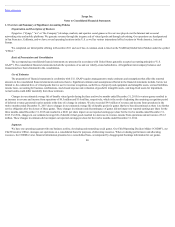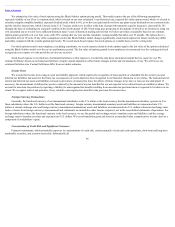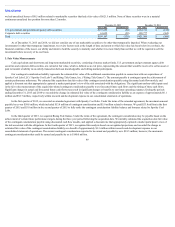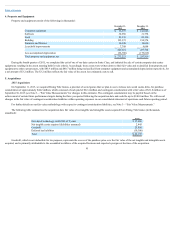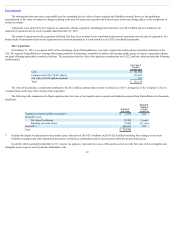Zynga 2015 Annual Report Download - page 85
Download and view the complete annual report
Please find page 85 of the 2015 Zynga annual report below. You can navigate through the pages in the report by either clicking on the pages listed below, or by using the keyword search tool below to find specific information within the annual report.
Table of Contents
On a quarterly basis, we determine the estimated average playing period for paying players by game beginning at the time of a payer’s first purchase in that
game and ending on a date when that paying player is no longer playing the game. To determine when paying players are no longer playing a given game, we
analyze monthly cohorts of paying players for that game who made their first in-game payment between six and 18 months prior to the beginning of each quarter
and determine whether each player within the cohort is an active or inactive player as of the date of our analysis. To determine which players are inactive, we
analyze the dates that each paying player last logged into that game. We determine a paying player to be inactive once they have reached a period of inactivity for
which it is probable (defined as at least 80%) that a player will not return to a specific game. For the payers deemed inactive as of our analysis date we analyze the
dates they last logged into that game to determine the rate at which inactive players stopped playing. Based on these dates we then project a date at which all paying
players for each monthly cohort are expected to cease playing our games. We then average the time periods from first purchase date and the date the last player is
expected to cease playing the game for each of the monthly cohorts to determine the total playing period for that game. To determine the estimated average playing
period we then divide this total playing period by two. The use of this “average” approach is supported by our observations that paying players typically become
inactive at a relatively consistent rate for our games. If future data indicates paying players do not become inactive at a relatively consistent rate, we will modify
our calculations accordingly. When a new game is launched and only a limited period of paying player data is available for our analysis, then we also consider
other factors, such as the estimated average playing period for other recently launched games with similar characteristics, to determine the estimated average
playing period.
Future usage patterns may differ from historical usage patterns and therefore the estimated average playing periods may change in the future. We assess the
estimated average playing period for paying players and the estimated average life of our virtual goods quarterly. Changes in our estimated average life of durable
virtual goods during the twelve months ended December 31, 2015 for various games resulted in an increase in revenue, income from operations and net income of
$1.0 million, which is the result of adjusting the remaining recognition period of deferred revenue generated in prior periods at the time of a change in estimate.
These changes in estimates did not impact our reported earnings per share for the twelve months ended December 31, 2015.
From July 2010 through the third quarter of 2013, Facebook’s proprietary virtual currency, Facebook Credits, was the primary in-game payment method for
our games played on the Facebook platform. Under the terms of our agreement with Facebook, Facebook set the price our players pay for Facebook Credits and
collected the funds from the sale of Facebook Credits. Facebook’s stated face value of a Facebook Credit was $0.10. For each Facebook Credit purchased by our
players and redeemed in our games, Facebook remitted to us $0.07, which is the amount we recognized as revenue. Accordingly, we recognized revenue net of the
amounts retained by Facebook related to Facebook Credits transactions because we did not set the pricing of Facebook Credits sold to the players of our games on
Facebook. In July 2013, Facebook began to transition payments made on the Facebook platform from Facebook Credits to Facebook’s local currency-based
payments program. This transition was completed in the fourth quarter of 2013. Under the terms of our agreement, Facebook remits to us 70% of the price we
request to be charged to the game player for each transaction. We recognize revenue net of the amounts retained by Facebook related to Facebook local currency-
based payments because Facebook may choose to alter our recommended price, for example by offering a discount or other incentives to players playing on their
platform. Additionally, we do not receive information from Facebook indicating the amount of such discounts offered to our paying players or regarding the actual
cash paid by our players to Facebook. Accordingly, we are unable to determine the gross amount paid by our players to Facebook.
For revenue earned through certain mobile platforms, including Apple iOS and Google Android, we recognize online game revenue based on the gross
amount paid by the player because we are the primary obligor and we have the contractual right to determine the price to be paid by the player. We record the
related platform and payment processing fees as cost of revenue in the period incurred.
We estimate chargebacks from our third-party web and mobile payment processors to account for potential future chargebacks based on historical data and
record such amounts as a reduction of revenue.
82





